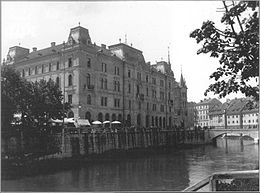
The Kresija Building or Kresija Palace (Slovene: palača Kresija) is a building that along the Philip Mansion marks the entrance to the old town of Ljubljana, the capital of Slovenia. It stands at the Adamič and Lunder Embankment (Adamič-Lundrovo nabrežje) on the right bank of the Ljubljanica immediately downstream of the Triple Bridge, bordering Pogačar Square (Pogačarjev trg), Stritar Street (Stritarjeva ulica), and Maček Street (Mačkova ulica). Until 2007, the building housed the Ljubljana Center Administrative Unit. Now, there are municipal offices, the Kresija Gallery, and the Ljubljana visitor centre.
History

The name of the building derives from the German Kreisamt, referring to the administrative office of the local Austro-Hungarian Kreis or district. Prior to the 1895 Ljubljana earthquake, there was a hospital and school building at the site. It housed a maternity hospital, a midwifery school as the first healthcare institution where courses took place in Slovene as well as a surgery repetition school established in 1753 by the physician Gerard van Swieten. Through the first half of the 19th century, there were shops and apartments in the building and the Ljubljana district office occupied its first floor. St. Elizabeth's Church stood next to it until 1831.
Architecture

The building has an irregular square plan and an inner court. It is noted for its Neo-Renaissance façades and interior. The decoration reminds of the Baroque. It was designed by the Graz architect Leopold Theyer and erected in 1897 and 1898, after the earthquake in 1895. The entrance portal of the building faces the Adamič and Lunder Embankment. There is a balcony with a wrought iron fence above it, and above the balcony, there is a coat of arms of the town of Ljubljana in a cartouche, encased with a sculpture of a genius on each side. The genii are work of the sculptor Alojzij Repič (1866–1941).
Memorials
Since 1999, the southwestern façade of the Kresija Building has been adorned with two busts facing Stritar Street: a bust of the Protestant grammarian Adam Bohorič and a bust of the 17th-century physician Marko Gerbec. Below a turret at the northwestern corner, a plaque was installed in 2005 in remembrance of the Manoeuvre Structures of National Protection, a paramilitary force that secretly operated in the building in 1991 and contributed to the achievement of Slovenian independence. In 2008, another plaque was installed, dedicated to the Ljubljana Coordination Group of Independence Efforts in 1991.
References
- ^ "Filipov dvorec in Kresija" [Philip Mansion and Kresija]. Arhitekturni vodnik (in Slovenian). Zavod Trajekt. Archived from the original on 13 August 2020. Retrieved 28 May 2012.
- "5595: Ljubljana - Kresija" [5595: Ljubljana – Kresija]. Register nepremične kulturne dediščine (in Slovenian). Ministrstvo za kulturo Republike Slovenije. Retrieved 29 February 2012.
- "Za Kresijo na mestu še nimajo novih načrtov" [The Town Has no Plans for Kresija Yet]. Dnevnik.si (in Slovenian). 14 November 2011.
- Dobnik, Jože (2006). "Točka Ljubljana" [Point: Ljubljana]. Pot kurirjev in vezistov NOV Slovenije [Path of Couriers and Operators of the National Liberation War of Slovenia] (in Slovenian). Društvo Domicilnega odbora kurirjev in vezistov NOV Slovenije. ISBN 961-238-581-5. Retrieved 28 May 2012.
- ^ "Kresija – stanovska latinska šola – Adam Bohorič – protestantsko šolstvo" [Kresija – Protestant Estates' Latin School – Adam Bohorič – Protestant Education]. Sprehod po poti kulturne dediščine šolstva v Ljubljani [A Walk Along the Path of the Cultural Heritage of Education in Ljubljana. Slovenian School Museum. Retrieved 28 May 2012.
- Petelin, David (November 2018). "Zdravstvena oskrba Ljubljančanov" (PDF). Glasilo Ljubljana. ISSN 1318-797X.
- Andrejka, R. (19 April 1935). "Ljubljanske ulice, ki so izginile" [Streets of Ljubljana that Have Disappeared]. Slovenec: političen list za slovenski narod. Vol. 62, no. 91a. Ljudska tiskarna. ISSN 1408-2381.
- Stare, Vida (1991). "Pokopališče pri sv. Elizabeti v Špitalski ulici v Ljubljani" [The Cemetery at St. Elizabeth's Church in Hospital Street in Ljubljana]. Kronika: časopis za slovensko krajevno zgodovino (in Slovenian). 39 (3). Association of Slovenian Historical Societies, Section for the History of Places. ISSN 0023-4923.
- ^ Lutman, Marjana. "Kresija". In Šmid Hribar, Mateja; Golež, Gregor; Podjed, Dan; Kladnik, Drago; Erhartič, Bojan; Pavlin, Primož; Ines, Jerele (eds.). Enciklopedija naravne in kulturne dediščine na Slovenskem – DEDI (in Slovenian). Retrieved 28 May 2012.
- Rožič, Janko (2010). "Nacionalni slog v arhitekturi" [National Style in Architecture]. 46. seminar slovenskega jezika, literature in kulture: Slovanstvo v slovenskem jeziku, literaturi in kulturi [The 46th Seminar of the Slovene Language, Literature, and Culture: Slavism in the Slovene Language, Literature, and Culture] (PDF) (in Slovenian). p. 135. ISBN 978-961-237-363-4. Archived from the original (PDF) on 2011-06-04. Retrieved 2014-04-14.
External links
- [REDACTED] Media related to Kresija Building at Wikimedia Commons
46°3′3.64″N 14°30′24.52″E / 46.0510111°N 14.5068111°E / 46.0510111; 14.5068111
Categories: